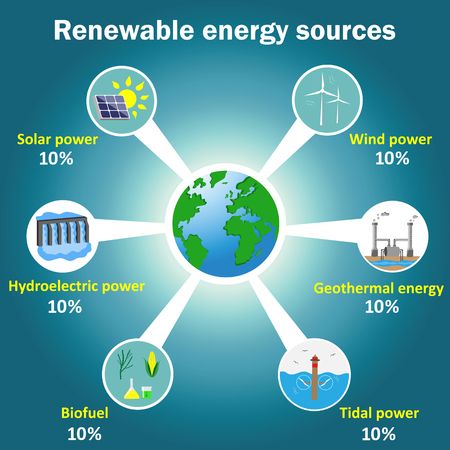In the contemporary discourse surrounding energy production, the sustainability and environmental impacts of various energy sources have gained unprecedented attention. The debate surrounding the efficacy of renewable energy vis-à-vis fossil fuels delves into a myriad of dimensions, encompassing ecological, economic, and technological perspectives. It is imperative to systematically dissect whether renewable energy is inherently better for the environment, transcending simplistic affirmations and exploring the multifaceted implications.
At the outset, it is critical to delineate what constitutes renewable energy. It encompasses sources that are naturally replenished on a human timescale, including solar, wind, hydroelectric, and biomass energy. The appeal of renewables lies not only in their abundance but also in their potential to mitigate climate change by reducing greenhouse gas emissions. Yet, a closer examination reveals conspicuous complexities in this narrative.
To understand the environmental ramifications of renewable energy, one must first investigate the lifecycle of these energy sources, from extraction or harvesting to energy production and ultimately to decommissioning. For instance, while solar panels offer a downstream reduction in carbon emissions during their operational phase, the manufacturing process requires significant energy input and raw materials such as silicon, which involve mining operations that can be ecologically detrimental. The extraction of rare earth minerals for wind turbines exhibits similar environmental strains, including habitat destruction and soil degradation.
Furthermore, the dispersal of renewable energy installations can engender localized ecological disturbances. Wind farms, for example, can impact avian populations through collision risks and habitat alteration. Studies have documented adverse effects on migratory birds and bats, prompting a critical examination of the ecological trade-offs inherent in wind energy production. The development of hydroelectric power, while a quintessential renewable source, often necessitates substantial changes to river systems. Dams can impede aquatic ecosystems, disrupt fish migration, and alter hydrology, thereby affecting the broader ecological framework.
Moreover, the intermittent nature of renewable energy sources presents challenges that can inadvertently lead to increased reliance on fossil fuels. In regions where wind or solar energy provision is unreliable, traditional power plants may need to compensate, resulting in a juxtaposition of renewable deployment with continued fossil fuel dependence. This dichotomy raises queries about the overall carbon footprint of systems predominantly utilizing renewables yet lacking energy storage capabilities. Thus, without robust technologies for energy storage or advanced grid integration, the promised decarbonization benefits may remain substantially unfulfilled.
Another salient point of consideration is the socio-economic repercussions tied to renewable energy deployment. The transition to renewable sources often necessitates substantial upfront investment and infrastructure development, which can present formidable barriers for developing economies. Furthermore, the employment generated in renewable sectors—including installation, operation, and maintenance—can fluctuate significantly, often leading to economic insecurity in these nascent markets. Thus, while renewable energy holds transformative potential, the socio-economic context must be intertwined with environmental considerations, creating a more nuanced assessment of its true environmental advantages.
Environmental justice also comes to the forefront of the renewable energy discourse. The placement of renewable energy projects often disproportionately affects marginalized communities, leading to issues pertaining to land use and displacement. The top-down approach in some instances disregards the voices of local populations, resulting in conflicts over land rights, particularly in regions where indigenous communities are involved. Hence, the environmental narrative surrounding renewable energy gains depth when juxtaposed with ethical considerations concerning equity and access.
Additionally, the increasing scale of renewable energy projects correlates with an expansion of infrastructure, such as transmission lines and road networks leading to rural areas. This development can incite further ecological disruption. The phenomenon of land-use change—as seen in large solar arrays or expansive wind farms—poses questions about habitat loss and land degradation. Consequently, an expansive growth in renewable energy must be tempered with prudent land-use planning to minimize adverse effects on ecosystems.
Moreover, one must interrogate the longevity and sustainability of renewable energy technologies. While renewables are often heralded for their low operational emissions, their longevity depends on effective recycling and waste management processes at the end of their lifecycle. For instance, retired solar panels and wind turbine blades pose significant waste disposal challenges, emphasizing the necessity for circular economic practices in the renewable sector. Addressing the end-of-life issues is paramount to ascertain that the benefits of renewables extend beyond their operational phase.
In conclusion, the inquiry into whether renewable energy is conclusively better for the environment reveals a complex tapestry of interconnected factors. While renewables can play a pivotal role in decreasing greenhouse gas emissions and fostering sustainability, an unequivocal assertion of their superiority is fraught with caveats. The ecological, socio-economic, and ethical dimensions of renewable energy production demand a comprehensive and holistic examination. Striving for a balanced approach that respects both environmental imperatives and social equity is essential for achieving truly sustainable energy systems. Thus, the promise of renewable energy lies not merely in its classification as ‘green’ but in the diligent application of knowledge and practices that safeguard the environment for future generations.










